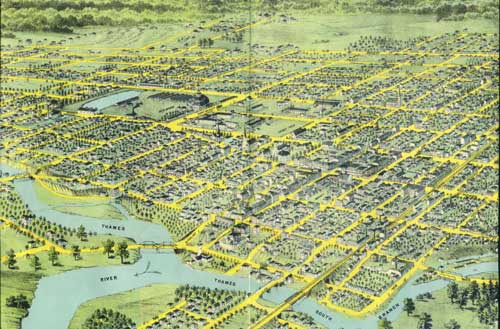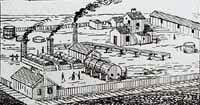

 |
 Spectacular growth in the years between 1850 and 1855 saw London's population double to 10,000 and in the latter year, the town was reincorporated as a city. London survived a short, severe depression in the late 1850s, caused by several failed wheat crops and land speculation in the wake of railway construction. Recovery was spurred by the discovery of oil in neighbouring Lambton County and the development of a number of refineries in East London. Spectacular growth in the years between 1850 and 1855 saw London's population double to 10,000 and in the latter year, the town was reincorporated as a city. London survived a short, severe depression in the late 1850s, caused by several failed wheat crops and land speculation in the wake of railway construction. Recovery was spurred by the discovery of oil in neighbouring Lambton County and the development of a number of refineries in East London.
 Some of London's larger industries found markets in the newly opened Canadian West as well as the surrounding countryside, now a flourishing agricultural district. Implement makers such as Murray Anderson, Samuel Crawford and John McClary (later known for his stoves), supplied horse-drawn plows and cultivators. On Ridout Street, across from Eldon House, Elijah Leonard, an iron founder, built Western Ontario's first steam engine and, by 1880, at least two London companies were turning out binders, a horse-drawn machine that could cut and bind a sheaf of grain in seconds, putting the cradle on the shelf for good. Some of London's larger industries found markets in the newly opened Canadian West as well as the surrounding countryside, now a flourishing agricultural district. Implement makers such as Murray Anderson, Samuel Crawford and John McClary (later known for his stoves), supplied horse-drawn plows and cultivators. On Ridout Street, across from Eldon House, Elijah Leonard, an iron founder, built Western Ontario's first steam engine and, by 1880, at least two London companies were turning out binders, a horse-drawn machine that could cut and bind a sheaf of grain in seconds, putting the cradle on the shelf for good.
Other industries such as furniture making and boot and shoe making grew out of small workshops with a few craftsmen into large factory operations. Factory owners found in London an ever-present pool of fairly well-educated workers, good rail connections to all parts of the US and Canada and a strong banking and investment community (with one exception). In fact, much of the wealth generated in industry, wholesaling and oil refining went into the creation of local financial institutions such as London Life (1874) and the Huron and Erie Savings and Loan (later known as Canada Trust).
In the 1880s, a series of calamities including the Donnelly murders (1880), the sinking of the steam ship Victoria (1881) and a terrific flood in West London which killed 17 people (1883), focused national attention on the area.
|
 | |
|

 Some of London's larger industries found markets in the newly opened Canadian West as well as the surrounding countryside, now a flourishing agricultural district. Implement makers such as Murray Anderson, Samuel Crawford and John McClary (later known for his stoves), supplied horse-drawn plows and cultivators. On Ridout Street, across from Eldon House, Elijah Leonard, an iron founder, built Western Ontario's first steam engine and, by 1880, at least two London companies were turning out binders, a horse-drawn machine that could cut and bind a sheaf of grain in seconds, putting the cradle on the shelf for good.
Some of London's larger industries found markets in the newly opened Canadian West as well as the surrounding countryside, now a flourishing agricultural district. Implement makers such as Murray Anderson, Samuel Crawford and John McClary (later known for his stoves), supplied horse-drawn plows and cultivators. On Ridout Street, across from Eldon House, Elijah Leonard, an iron founder, built Western Ontario's first steam engine and, by 1880, at least two London companies were turning out binders, a horse-drawn machine that could cut and bind a sheaf of grain in seconds, putting the cradle on the shelf for good.
